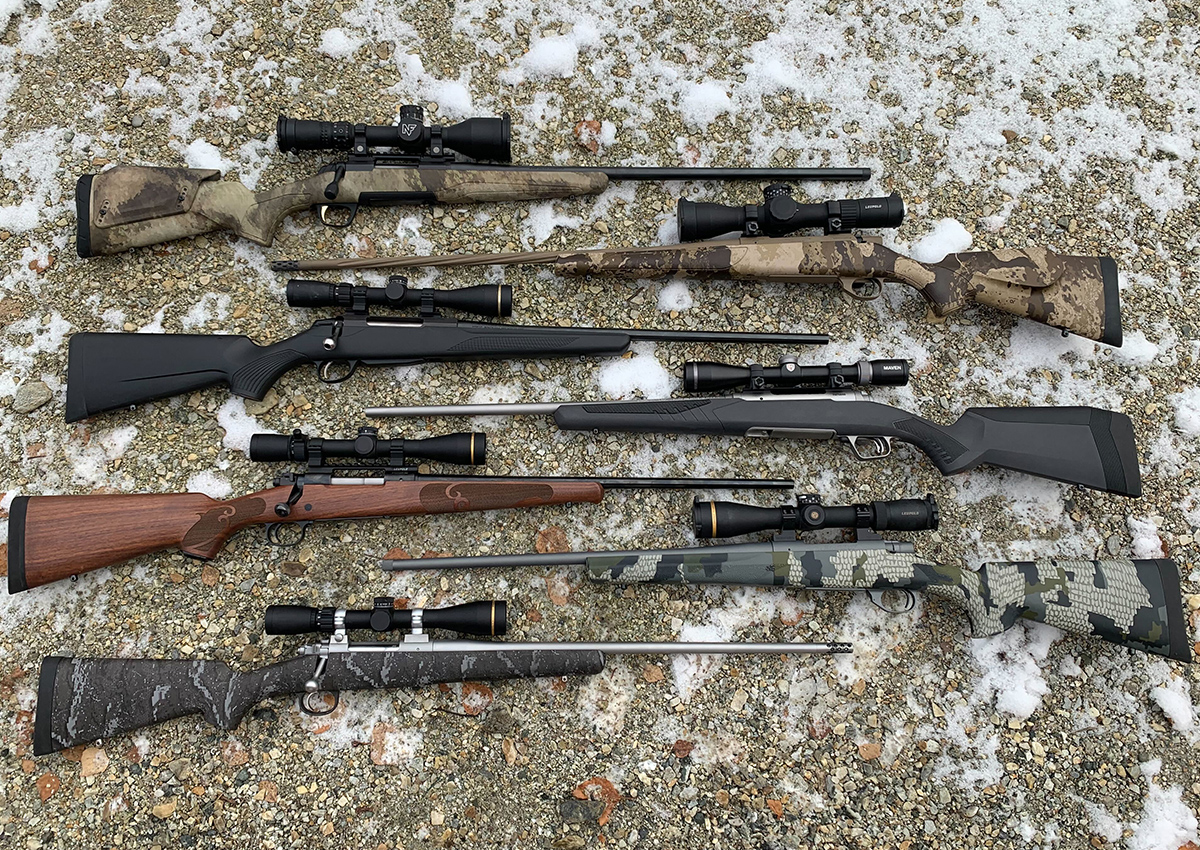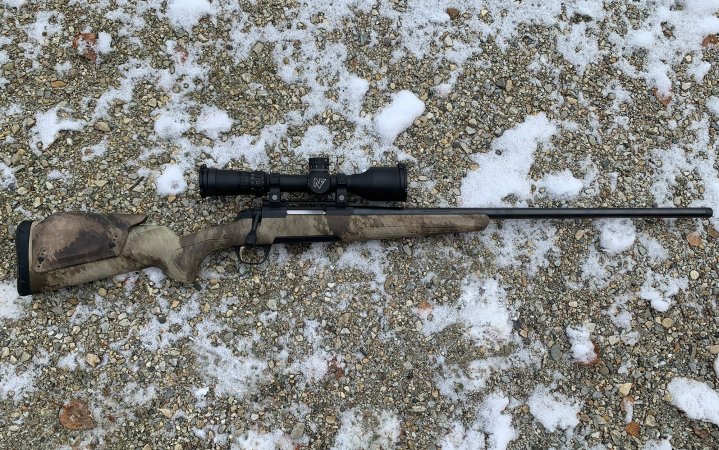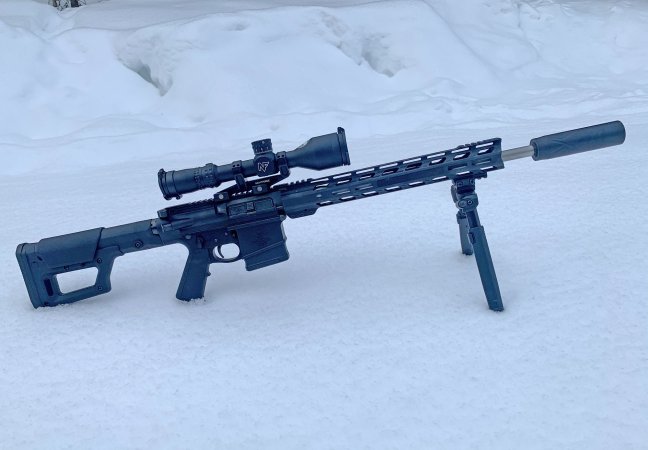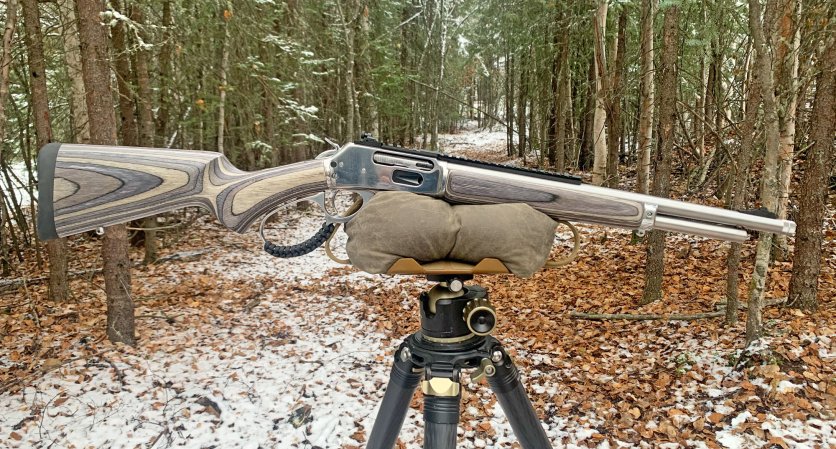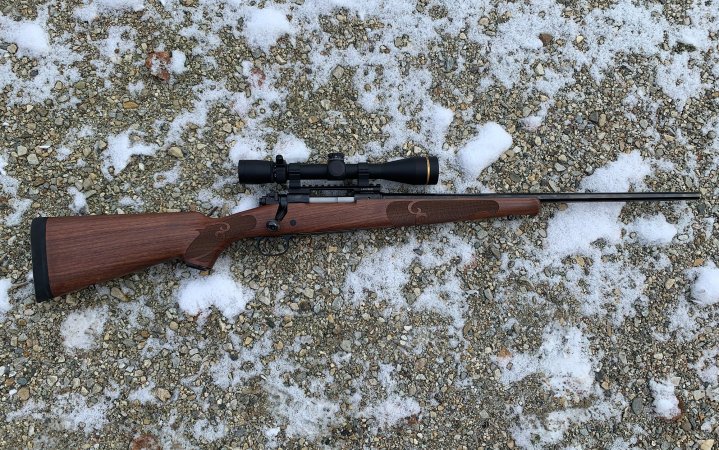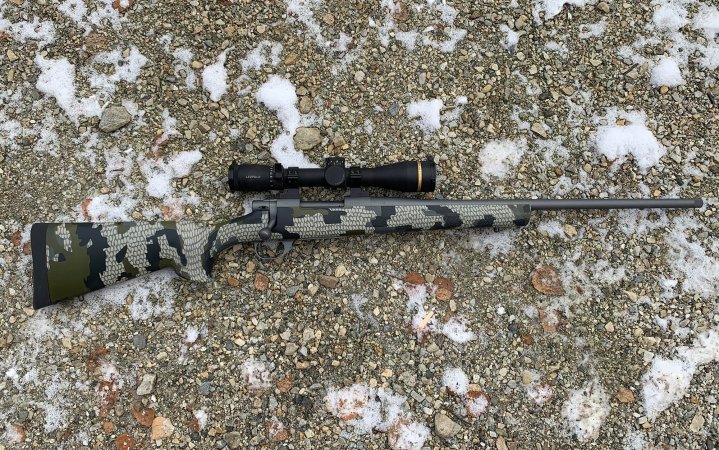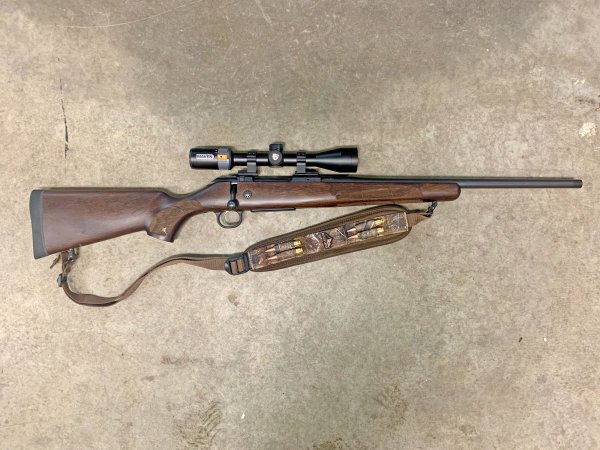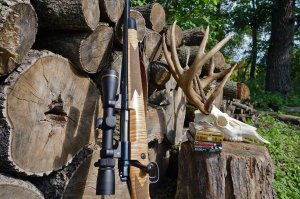We may earn revenue from the products available on this page and participate in affiliate programs. Learn More ›
Best for the Money
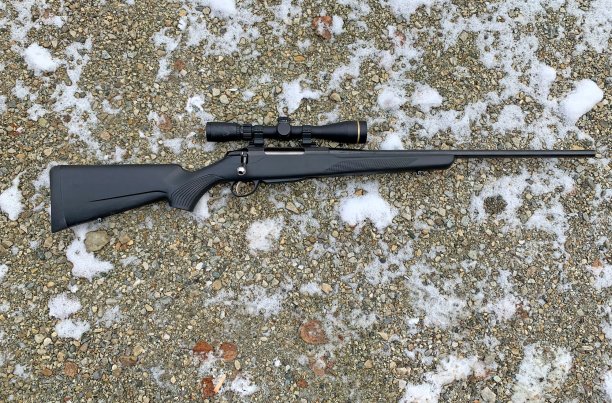
Tikka T3X Lite
Best Mid-Priced AR
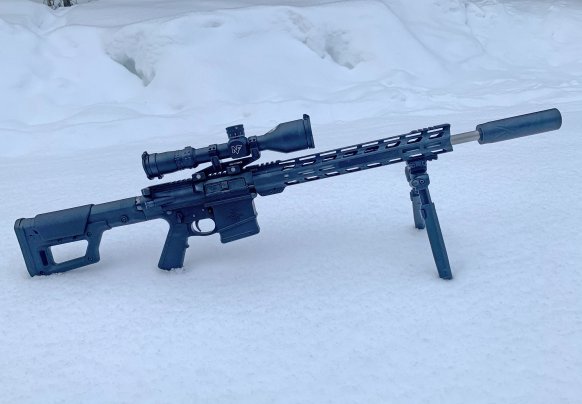
PSA Sabre 10
Best Mid-Priced Lever Gun

Rossi R95 Laminate .45/70
Long before I was a writer at Outdoor Life, I was an OL reader, and mid-priced hunting rifles were my bread and butter. I grew up with modest means, so when it came to buying a hunting rifle, I sought out the best information I could in order to spend my money wisely. I know you appreciate value and an honest evaluation, especially when it comes to hunting rifles.
A hunting rifle is a significant purchase for most people and narrowing the field can be difficult. Hunting rifles can range from around $350 to north of $7,000, which is quite a staggering spread. All hunters want to find that sweet spot between price and quality. We strive to give you valid information on rifles of every price point from budget hunting rifles to premium custom builds.
This is a comparison of mid-priced rifles, retailing from $700 to $1,300, which captures many of the most popular hunting rifles on the market. That’s because so many hunters are willing to spend a little more for a nicer rifle, but don’t want to throw down on a $2,000 gun. This price block has traditionally included mainstream flagship rifles like the Winchester Model 70 and Remington Model 700, Savage Model 110, and others. It is in this range of mid-priced hunting rifles that the average hunter will likely spend their money.
- Best for the Money: Tikka T3X Lite
- Best for Long Range: Browning X-Bolt Western Hunter LR
- Best Mid-Priced AR: PSA Sabre 10
- Best Mid-Priced Lever Gun: Rossi R95 Laminate .45/70
- Winchester Model 70 Featherweight
- Howa Model 1500
- Savage 110 Storm
- Weatherby Vanguard First Lite
- CZUSA 600 American
What Can You Expect from a Mid-Priced Hunting Rifle?
Mid-priced hunting rifles are typicaly nice, but without many frills or flourishes. They are general production, standard rifles that are made of good, economical materials with basic stocks and run-of-the-mill triggers. Some at the top end of this price range historically have features like better coatings or threaded muzzles — though with the popularity of suppressors for hunting, threaded muzzles are becoming a new standard.
You’ll see better-quality parts and workmanship on mid-priced hunting rifles than their bargain basement counterparts. Bargain rifles use cost-cutting parts and construction methods to keep prices down. The rifles that cost a few hundred dollars more will usually have nicer stocks, finishes, fit, and more consistent accuracy. The mid-priced hunting rifle is the bread-and-butter standard to which both lower and higher-priced rifles are compared.
Accuracy Testing Mid-Priced Hunting Rifles
The Outdoor Life staff has always strived to present you with the most relevant and practical data for rifle accuracy. At one time, we believed that three-shot groups told us what we needed to know. Then, after seeing too much variability, it became five-shot groups, and averages of large numbers of five-shot groups.
Within the last couple years, we have realized that even that doesn’t give us the best information for evaluating or comparing rifles — or knowing what we can expect from them in the field. Based on the statistical and range-tested information that the guys in the lab at Hornady presented in their podcast series beginning with Your Groups are Too Small, we took a fresh look at our accuracy protocol and found it lacking.
We will still present you with five-shot group accuracy data, but we’ve also developed an easy method to take those five-shot groups and compile them into a 20-shot composite, which is a much better representation of how the rifle actually shoots and can be expected to shoot. We also look at a 20-shot Mean Radius. You can read about how to do that, and some of the benfits, here.
We tested some of the rifles in this story using our old protocol, but as we get to re-test some, and test more current versions of others, we will keep this story populated with the best data that we have for each mid-priced hunting rifle. All rifles were tested with multiple types of quality ammunition. All recorded groups were fired from either bench or prone positions, with front and rear support.
Best Mid-Priced Rifles: Reviews and Recommendations
Best for the Money: Tikka T3X Lite
Pros
- Excellent price
- 70-degree throw, smooth bolt
- Good accuracy
- Great trigger
Cons
- Finish rusts easily
Key Features
- Cartridge Tested: .308 Win.
- Capacity: 3+1 rounds, detachable box magazine
- Action: Bolt action, two-lug, 70-degree throw
- Stock: Polymer, 1-inch recoil pad, modular grip
- Weight: 6 lb. 9 oz. (measured)
- Trigger: Single-stage, 3 lb. 2 oz. (measured)
- Barrel: 22 in., blued
- Overall Length: 42.5 in.
- Price: $710
Accuracy Data
Average Five-Shot Group Size (27 Groups total): 1.96 inches
The Tikka T3X family has a cult-like following, especially here in Alaska. These rifles are affordable, accurate, and dependable. They aren’t ultralight, but aren’t too heavy either. The Finnish rifles have a proven track record and are never a bad option for someone looking for a mid-priced hunting rifle.
The T3X Lite is a sleek and simple rifle. It’s like a budget rifle, only nicer in just about every way. It features a closed-top action and simple two-lug stainless-steel bolt. It has a short bolt throw for a two-lug action, and it’s exceptionally crisp and smooth for its class. The bolt features a metal rear shroud, and the bolt handle is dovetailed into the bolt body.

The stock is a simple black injection-molded polymer but has excellent texturing on the fore-end and interchangeable grip. It fits the action and barrel nicely. The trigger guard and bottom plate are polymer, and the single-stack polymer magazine extends below the bottom of the stock without impeding single-handed carry.
The rifle is plain but shows good craftsmanship and attention to detail. Even the small textured portion of the bolt release button matches the texture pattern of the stock—a nice touch. Overall, the T3X Lite is a very sleek and clean rifle, with no sloppy machine work or tool marks. It’s very well-balanced for an all-around hunting rifle. The only complaint I could come up with is that the blued sample I have has a finish that is very susceptible to surface rust, so keep it oiled up or pick the stainless model for $190 more!
Best for Long Range: Browning X-Bolt Western Hunter LR
Pros
- Smooth action and crisp trigger
- Adjustable comb on stock
- Medium-heavy barrel is suppressor ready
- Very accurate
Cons
- No rail for bipod
Key Features
- Cartridge Tested: 6.8 Western
- Capacity: 3+1 rounds, detachable rotary magazine
- Action: Bolt action, three-lug, 60-degree throw
- Stock: Composite, In-Flex recoil pad, adjustable comb
- Weight: 8 lb. 2 oz. (measured)
- Trigger: Single-stage, 3 lb. 12 oz. (measured)
- Barrel: 24 in., blued, sporter SR contour, threaded
- Overall Length: 46.25 in.
- Price: $1,000
Accuracy Data
Average Five-Shot Group Size (20 groups): 1.28 inches
The Browning X-Bolt is a highly popular flagship model rifle, and for good reason. They’re generally accurate, dependable, and come in a variety of configurations. Many of their configurations pushes them beyond the category of mid-priced hunting rifles, but the X-Bolt Western Hunter LR can be found at retailers for under $1,200.
The X-Bolt is a three-lug push-feed action that’s fed from a rotary magazine with a rounded bottom, which sits flush with the profile of the stock. It uses an M-16-style extractor and single plunger ejector. It has a two-position safety on the tang that locks the bolt closed when engaged, but the bolt has an override button to allow the shooter to open the bolt or unload while the rifle is on “safe.” The cheek piece is comfortable, and the pistol grip aids with consistent hand placement and trigger pull.
This rifle is a middle ground between more standard sporter-weight and lightweight rifles like the Speed and Mountain Pro, and some of their heavier target models. As the name implies, the Western Hunter LR is designed to be a rifle that’s handy enough to pack around, but capable of shooting game at longer distances.
To hit that middle ground, the standard X-Bolt action is fitted with a medium-heavy 24-inch threaded barrel and sits in a standard-sized stock like you might see on the X-Bolt Speed. However, this stock includes an adjustable cheek piece, and the action comes fitted with a 20-MOA Picatinny rail. The metal is all blued finish, and the camo stock is now being made in Browning’s OVIX pattern, although mine is in ATACS.
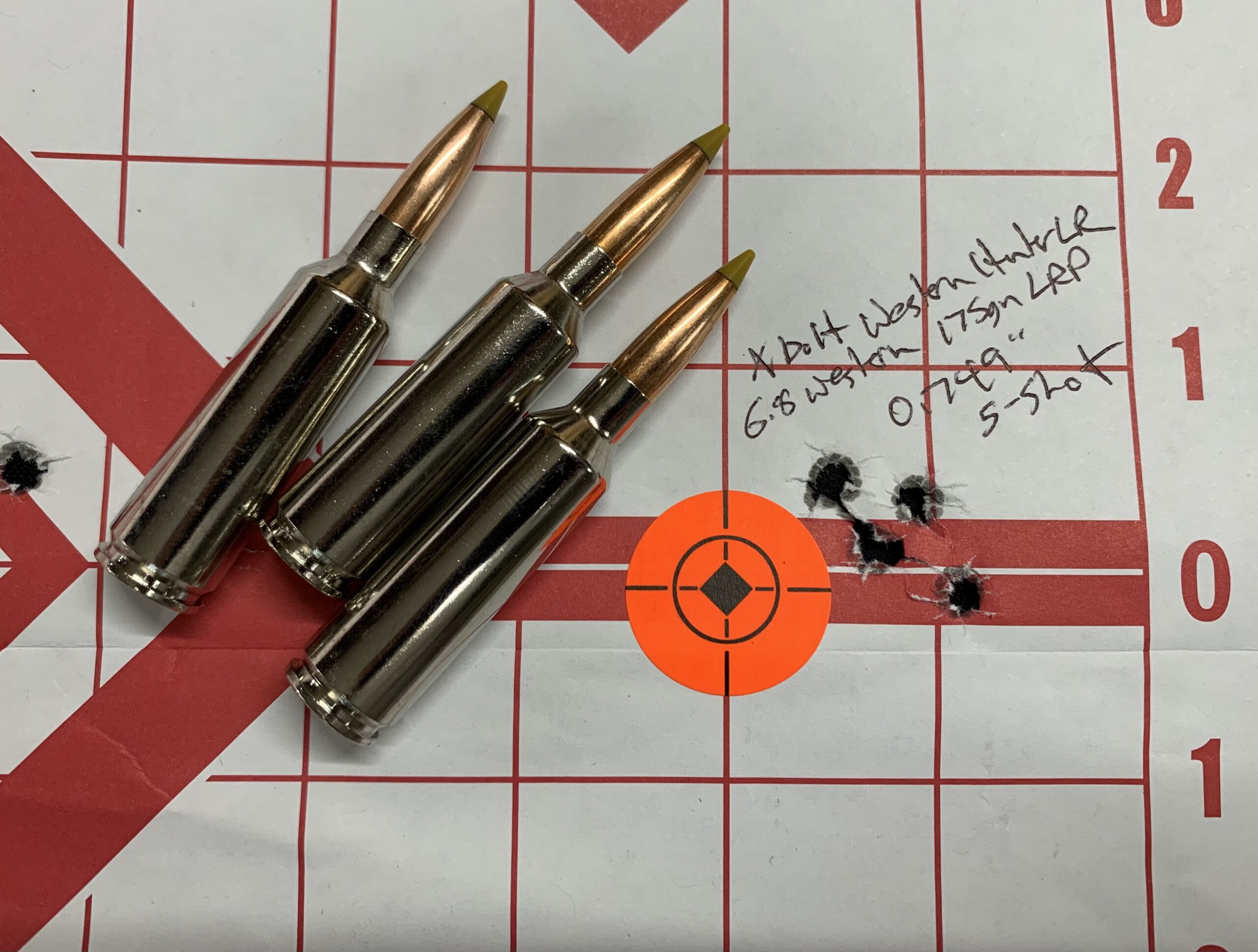
Best Mid-Priced AR: PSA Sabre 10
Pros
- Good value
- Good trigger
- Excellent accuracy
- Nice stock
Cons
- Need to tune gas to run properly
- Could use a heavier buffer
Key Features
- Cartridge Tested: 6.5 Creedmoor
- Capacity: Variable, uses AR-10 Magazines
- Action: Semi-auto, direct impingement
- Stock: Magpul PRS Lite
- Weight: 9 lb. 10 oz. (measured)
- Trigger: two-stage, 2 lb. 7 oz. (measured)
- Barrel: 18 inches, stainless, threaded 5/8-24
- Price: $1,250
Accuracy Data
Average Five-Shot Group Size (37 groups): .952 inches
20-Shot Group Size (Hornady 143-grain Precision Hunter): 1.13 inches,
20-Shot Mean Radius (Hornady 143-grain Precision Hunter): .34 inches
Known for their affordable rifles, 9mm carbines, and Glock clone handguns like the PSA Dagger, Palmetto State Armory has a hell of a good rifle in the PSA Sabre 10. I got one of these to test, chambered in 6.5 Creedmoor, and was floored by its accuracy. The PSA Sabre 10 is designed to replicate the M110 service rifle, but at a much lower price point. It’s not very flashy, but includes key quality components like a Magpul PRS Lite adjustable stock, a Radian Raptor charging handle, stainless-steel barrel, and adjustable gas block. The bolt also uses double springs on the extractor and dual plunger ejectors for reliable extraction and ejection.
Read More: PSA Sabre 10 Full Review
It took me a while to get the ideal bolt speed down — which I manipulated by adjusting the gas system. Eventually, I added a heavier buffer too. I did find that I needed to fine-tune the system any time I switched ammo or added a suppressor. For anyone wanting an affordable, quality AR to hunt with, these requirements are a small price to pay. I shot a lot of different ammo through the Sabre 10, and loads using Hornady’s 143-grain ELD-X were best. This rifle is more accurate than most of the bolt-action hunting rifles on this list. It would be an excellent choice for hunting hogs at night using a thermal scope.
Best Mid-Priced Lever Gun: Rossi R95 Laminate .45/70
Pros
- Weather-resistant finish
- Smooth action
- Improved extractor
- Optic and suppressor ready
Cons
- Fore-end has too much flex
Key Features
- Cartridge Tested: .45/70 Gov’t
- Capacity: 5+1 rounds, tubular magazine
- Action: Lever-action
- Stock: Laminated wood
- Weight: 7 lb. 4 oz. (measured)
- Trigger: Single-stage, 5 lb. 13 oz. (measured)
- Barrel: 18 inches, stainless, threaded 5/8-24
- Overall Length: 36.75 in.
- Price: $1,084
Accuracy Data
Average Five-Shot Group Size (50 yards): 1.36 inches
Most people think of imported lever guns as little more than a novelty, but don’t make that mistake with Rossi. Their R95 is high quality and all business. The laminated .45/70 model that I tested has a smoother action than many of the older Marlins I have shot, though it does lag a bit behind the newer Ruger Marlins. I tested mine with a variety of loads including factory ammo from Black Hills ammo and Federal, as well as hand loads with bullets from Lehigh Defense and Speer, ranging from 300 grains to 405 grains. It cycled everything wonderfully, no doubt aided by it’s improved M16-style extractor. This rifle comes with a tall front bead sight and a rear peep, with a long length of Picatinny rail for mounting a red dot or LPVO. It handled heavy-recoiling rounds well, but before I did anything, I would remove all components and add thread locker — I did have some optic base screws loosen during testing.
Read More: Rossi R95 Laminate .45/70 Review
This is a modern-featured lever gun that’s ready for a suppressor, but also maintains a nostalgic look. For the price, it’s a really good value, though the receiver flats are a bit over polished, and if I squeeze the fore-end, it has some flex. I plan on either bedding it or swapping it out for an aftermarket set. If you want to get into a lever gun in the mid-priced hunting rifle market, this is a tough one to beat.
Winchester Model 70 Featherweight
Pros
- Classic Featherweight feel
- Good metal-to-wood fit
- Pre-64-style controlled-feed action
- Classic wood-stocked hunting rifle
Cons
- Mediocre Accuracy
Key Features
- Cartridge Tested: .308 Win.
- Capacity: 5+1 rounds, hinged floorplate
- Action: Bolt action, two-lug, pre-64-style controlled-feed
- Stock: Black Walnut, Pachmayr recoil pad, Featherweight checkering and Shnabel fore-end
- Weight: 7 lb. 0 oz. (measured)
- Trigger: Single-stage, 4 lb. 2 oz. (measured)
- Barrel: 22 in., blued, Featherweight contour, recessed target crown
- Overall Length: 42.25 in.
- Price: $1,120
Accuracy Data
Average Five-Shot Group Size (21 groups): 2.26 inches
The Winchester Model 70 Featherweight is one of the longest-running mid-priced hunting rifles that’s still in production. The featherweight was first released in 1952, and the signature “Featherweight” stock was introduced in 1982. The rifle has seen some changes, but the current production model has a pre-64-style controlled-feed action that Model 70 fans love.
The Featherweight was a lightweight rifle for its time and introduced in the brand new .308 W.C.F. cartridge of 1952 (what we now know as the .308 Win.). That’s what I tested the current production model in, and with the post-1982 Schnabel fore-end and signature checkering, it’s an authentic Featherweight.
Read More: Is the Winchester Model 70 Featherweight As Good As It Used to Be?
The controlled-feed action features a two-lug bolt and Mauser-style claw extractor, as well as a coned breech for feeding reliability. It also uses a blade ejector rather than a spring-loaded plunger. The blade ejector ejects cases with a force proportional to how hard the bolt is pulled to the rear. Need to reload in a hurry? Grip it and rip it. On the bench though, you can slowly pull the bolt to the rear and hand-pluck your spent case from the bolt face. Because the claw extractor grabs and controls the cartridge as soon as it’s stripped from the magazine, you don’t have to close the bolt to withdraw the cartridge from the chamber like you do with most push-feed rifles.

The wood stock is warm and comfortable and features good wood-to-metal fit with only a couple uneven spots on my sample. Unlike older models, the stock features bedding around the recoil lug and at the tang to help reinforce the wood and provide a more stable connection. My only complaint with the stock is that it’s slightly thicker and blockier than older model Featherweights, particularly in the grip and around the magazine floorplate.
The metal on the rifle features a nice satin blued finish, and the muzzle has a recessed target crown that’s well-protected. An older Model 70 Featherweight I have possesses only a slightly contoured crown, and the muzzle shows some wear from riding around on the floorboards of a pickup.
Howa Model 1500
Pros
- Three-position bolt-locking safety
- Durable, comfortable stock
- Excellent trigger
- Threaded muzzle
Cons
- Ejecting brass nicks receiver finish
Key Features
- Cartridge Tested: .308 Win.
- Capacity: 5+1 rounds, hinged floorplate
- Action: Bolt action, two-lug, push-feed, tactical gray Cerakote
- Stock: Hogue synthetic, pillar-bedded
- Weight: 7 lb. 9 oz. (measured)
- Trigger: Two-stage, 2 lb. 13 oz. (measured)
- Barrel: 22 in., tactical gray Cerakote, threaded ½-inch x 28
- Overall Length: 42.5 in.
- Price: $736
- Average Group Size: 2.20 in.
Accuracy Data
Average Five-Shot Group Size (22 Groups): 2.2 inches
The Howa 1500 is another long-running hunting rifle that has models in the $600-$1,200 price range. The Model 1500 has been in production since 1979, and it’s been a staple, affordable rifle for many hunters. I killed my first coyote with a 1500 in .223 that my dad bought when I was a kid, and one of the most accurate rifles I’ve ever owned was a heavy-barreled Model 1500 with a laminated thumbhole stock in .308 Win.
Like many rifles, the 1500 comes in a variety of configurations and price ranges—including carbon-fiber barrels and high-end stocks. One of the base models that fits this category perfectly is the Kuiu Verde in .308 Win. The rifle features a tactical gray Cerakote finish, sporter-weight barrel, and a Hogue Kuiu-camo stock with a wide fore-end, meaty grip, and soft recoil pad.
The Howa Model 1500 action is a simple two-lug push-feed action—much like the Remington 700. Unlike the 700, it features an M-16-style extractor, but does have a single plunger ejector on the bolt face. The recoil lug is machined into the action, and Howa’s trigger group is attached to the action with a single Allen screw.
Sitting in the stock, the barrel channel is even, and the barrel is free floated completely back to the receiver. The stock is beefy, but comfortable to shoot. It has a wide fore-end, and a thick, nearly vertical grip which makes a perpendicular pull on the trigger easy.
The barrel has a slightly recessed crown, and the muzzle is threaded, although it’s notable that the thread pitch is ½-inch x 28 (a threading that is most common with .22-caliber chamberings) rather than the more common 5/8-inch x 24. The muzzle is ready to be fitted with either a brake or suppressor. Because the barrel is a relatively light sporter weight, expect major point-of-impact shifts when adding a can.
Savage 110 Storm
Pros
- Adjustable stock with quality texturing
- Good, user-adjustable trigger
- Stainless-steel parts offer good corrosion resistance
- Steel Magazine is durable
Cons
- Excessive tool marks in the bore on my sample
- Magazine bottom plate shows spot rusting from ambient humidity
Key Features
- Cartridge Tested: .308 Win.
- Capacity: 4+1 rounds, detachable box
- Action: Bolt action, two-lug, push-feed, Stainless-steel
- Stock: Synthetic, adjustable Accustock with bedding block
- Weight: 7 lb. 9 oz. (measured)
- Trigger: Single-stage, Savage Accutrigger, 3 lb. 4 oz. (measured)
- Barrel: 22 in., Stainless-steel
- Overall Length: 42.25 in.
- Price: $725
Accuracy Data
Average Five-Shot Group Size (24 groups): 2.18 inches
The Savage Model 110 is a stalwart of the mid-priced hunting rifle category and has been since its introduction in 1963. In-fact, it was one of the major competitors that pushed Winchester to adopt a push-feed design for the Model 70 in 1964, according to Jack O’Connor’s writings at the time.
The Model 110 is a simple push-feed, bolt-action rifle that features a second set of lugs behind the forward set. This could still be considered a two-lug bolt because only the forward lugs rotate and lock into the receiver, but the rear ones spin freely around the bolt body and remain in the raceways while the bolt is locked into battery. The bolt handle is cast, and the bolt features a small plunger ejector and an extractor that’s fitted into the right-hand lug (something the push-feed Winchester Model 70 used as well).

The Savage Model 110 is a hunting rifle that was designed to be affordable and accurate, and it carries a reputation for both. The Model 110 Storm that I tested features a stainless-steel receiver and barrel, and a detachable 4-round magazine. I like the design of the magazine because it’s durable, but I did notice that the stainless-finish bottom plate has picked up some surface spot rusting simply from the ambient humidity. The loaded magazine takes firm pressure to insert into the rifle, but it springs free with authority when the magazine release is pressed.
The rifle features a 3-position tang safety that locks the bolt in its most rearward position. It also uses Savage’s Accutrigger—a user-adjustable trigger with a center safety tab. It’s a well-liked and crisp-breaking trigger that certainly aids with the shootability of the rifle.
Savage has made great improvements in their synthetic stocks in the last few years. They were often cheap-feeling with flimsy fore-ends, but the one on the Storm is well-executed, and has an internal bedding block. The floated barrel fits evenly in the barrel channel, the stock’s lines are clean, and it has an excellent rubberized grip texture on the fore-end and grip. The stock adjusts for comb height and length of pull.
My only significant complaint with my sample M110 Storm is that the bore on my sample has excessive tooling chatter marks that run perpendicular to the rifling. I noticed it after an initial firing and cleaning of the rifle. The marks are noticeable to the naked eye, and I could feel them by running a dental pick lightly along the inside of the bore. It’s not the norm on rifles that I’ve seen from Savage, but it’s something that I will be careful to look for in the future. A normal sample from them probably would have performed better, and I plan on re-testing another mid-priced rifle in the Model 110 series.
Weatherby Vanguard First Lite
Pros
- Great trigger
- Weatherby in-house Cerakote finish on metal parts
- Fluted Barrel
- Comfortable raised Monte Carlo comb on stock
Cons
- 6.5-300 chambering likely isn’t the most accurate choice for this rifle
Key Features
- Cartridge Tested: 6.5-300 Weatherby Magnum
- Capacity: 3+1 rounds, hinged floorplate
- Action: Bolt action, two-lug, push-feed, Cerakote finish
- Stock: Synthetic, First Lite Cipher camo finish
- Weight: 7 lb. 10 oz. (measured)
- Trigger: Two-stage, 3 lb. 3 oz. (measured)
- Barrel: 26 in., fluted, threaded with muzzle brake and thread protector, Cerakote Finish
- Overall Length: 48.5 inches (with muzzle brake)
- Price: $1,000
Accuracy Data
Average Five-Shot Group Size (15 groups): 1.96 inches
If you notice the resemblance between the Weatherby Vanguard series and the Howa 1500, it’s because they are very similar. Howa makes the barreled actions for the Vanguard line, though Weatherby finishes them in Sheridan, Wyo. by adding the stock, trigger, barrel fluting, finishes, etc. The Vanguard series was introduced in 1970 to offer a lower-priced option than the premium Mark V line, and firmly fits the bill for a quality mid-priced hunting rifle.
Like the Model 1500, the Vanguard is a two-lug push-feed action—nearly identical except for a few differences. One is that the Vanguard’s bolt features three small gas vent holes that are visible on the ejecting side when the bolt is closed. The Model 1500 only has the forward hole. Additionally, the Model 1500 has three larger vent holes in the bolt body that point down towards the magazine when the bolt is closed. The Vanguard only has one.

The Vanguard First Lite features a relatively slender, high-quality synthetic stock. The fore-end is slightly widened at the bottom with a slimming taper closer to the barrel. The Monte Carlo comb provides a comfortable and firm cheek weld, and the subtle texturing on the grip and fore-end make the rifle easy to handle and hold. The stock is finished with First Lite Cipher camouflage pattern.
One notable feature is the rifle’s Cerakote finish, which is even, good-looking, and done in-house at their Sheridan, Wyoming factory. The rifle includes both a slim radial muzzle brake and thread protector—both machined to fit the barrel profile perfectly. The fit is precise, and it’s hard to see the seam when the muzzle brake or thread protector are tightened.
In an apples-to-apples comparison, it’s probably not fair to shoot a fluted, sporter-weight 6.5-300 Wby Mag. against similar-class rifles in .308 Win. The 6.5-300 is an incredibly fast, flat-shooting cartridge, but it will heat up a barrel quickly and is generally much less forgiving than cartridges like the .308 Win. and 6.5 Creedmoor. However, the only sample Weatherby had available at the time was chambered for 6.5-300, and I was excited to see how it would fare. The rifle held it’s own.
CZUSA 600 American
Pros
- Very accurate
- Attractive wood stock
- Simple adjustable trigger
- Threaded muzzle
Cons
- Finish on stock can be easily damaged
Key Features
- Caliber Tested: .308 Winchester
- Capacity: 5-round detachable box magazine
- Action: Three-lug bolt
- Stock: Turkish Walnut
- Weight: 7 lb. 8 oz. (measured)
- Trigger: 1 lb. 7 oz., adjustable (measured)
- Barrel: 20 in., threaded 9/16-24
- Overall Length: 42.2 in.
- Price: $775
Accuracy Data
Average Five-Shot Group Size (29 groups): 1.28 inches
New for 2022, the CZ 600 series was a complete divergence from their previous actions and, following the CZ 600 Alpha, the CZ 600 American is a traditionally-styled wood-stocked version. It has a three-lug, push-feed action that uses a detachable box magazine. Our sample was chambered in .308 Winchester and featured a sporter-contoured barrel, anti-corrosion finish, and a checkered Turkish Walnut stock. It comes with a threaded muzzle, but it’s 9/16×24 rather than the American standard 5/8-24 and will require an adapter for use with most suppressors.
Read More: Full Review of the CZ 600 American
The CZ 600 American features an exceptionally idiot-proof adjustable trigger and it’s heft makes it very comfortable to shoot. The trigger features four adjustment positions similar to those on Sako rifles. It also features an over-sized bolt knob that makes running the short-throw action a breeze. The American isn’t light, but it’s not exceptionally heavy or long barreled either. It would make a great all-around woods rifle for any hunter.
The safety mechanism on the CZ 600 is interesting, as it’s a thru-tang safety that you press down into the tang to disengage, and up from the bottom to engage. The safety locks the bolt, but there is a bolt release button that can be pressed to open the bolt while the rifle is on safe.
Final Thoughts on Mid-Priced Hunting Rifles
The biggest takeaway from accuracy testing mid-priced hunting rifles is that they are generally a step above the budget rifles in accuracy. They will shoot a wider variety of loads with better consistency, but you still might have to spend some time on the bench to find what they really like. Several of the mid-priced rifles have MOA accuracy guarantees for three-shot groups, and I found them all to satisfy their claims.
Most rifles in this price block do fall short of the accuracy of premium rifles when it comes to five-shot groups over time, but this probably won’t bother the average hunter. Many people will claim that their mid-priced rifles will shoot just as accurately as any rifle in the $2,000 to $4,000 range, but that’s usually not true. Especially since we’ve started using larger sample sizes (20-shot group aggregates), we see that more expensive rifles are generally much more consistent than budget guns. That said, All of these are plenty accurate enough, so pick one that best meets your needs and get out and hunt.

